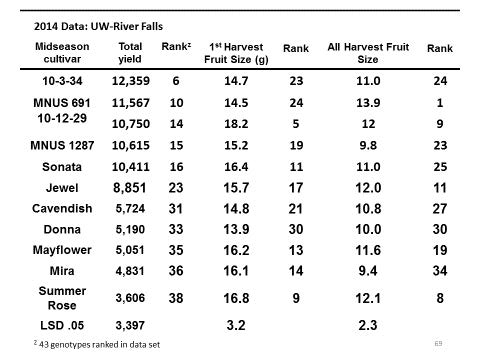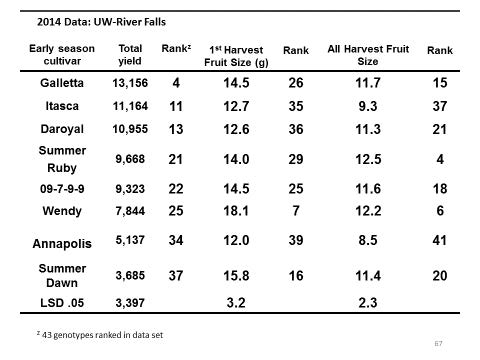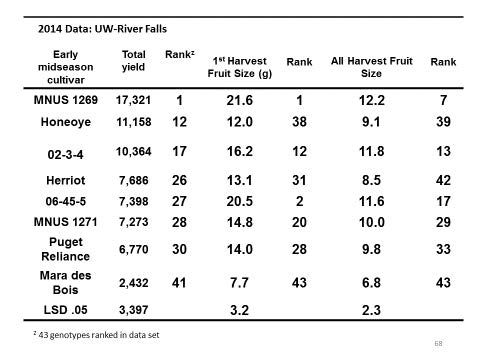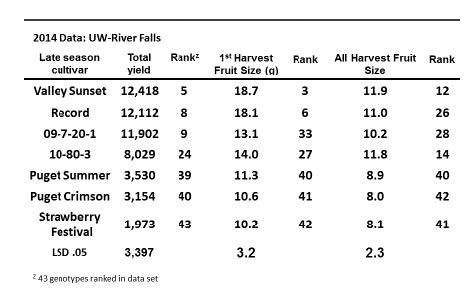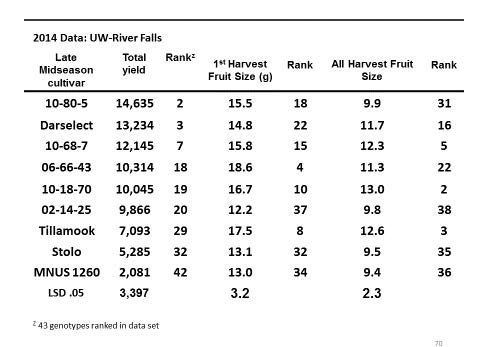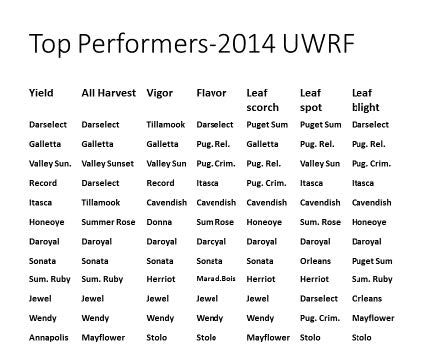Strawberry Cultivars and Your Farm Profitability: Results of Midwest Strawberry Performance Trials
Some of you reading this had the opportunity to attend presentations that I have given at conferences, workshops and field days. Most of you have either already planted your new strawberry fields or are nearly ready to. This article outlines some of the results that I have generated over the last several years that will hopefully give some more insight in to the realm of choosing the correct cultivar for your farm. While it cannot be denied that our Wisconsin/Midwest macroclimate is of the fast-changing continental type, individual characteristics of your own farm mesoclimate and business/marketing practices can change grower priorities as to cultivar selection. Some questions to ask yourself with regards to choice of cultivar can range from “What soil type do I have?” to “What avenues do I use to market my strawberries?” The wide choice of cultivars available today is both an advantage and a disadvantage, depending on how you make your decision to plant a certain amount of acreage.
Let’s take a look at grower options. One of the best starting points is to find out what cultivars have worked for the greater population of growers in an area. Cultivars such as ‘Annapolis’, ‘Honeoye’, ‘Cavendish’ and ‘Jewel’ are the “bread and butter” cultivars of the Midwest industry. They all have specific faults but when observed over a wide range of mesoclimates, they perform exceedingly well in terms of yield, general winter hardiness and adaptability. If we throw in variables to eliminate cultivars even from this generalized list, your options are limited. What if you have a heavier soil like a clay loam? Root disease resistance is of paramount importance, such as for red stele disease and black root rot complex.
‘Honeoye’ and ‘Jewel’ might not look so good as candidates in this situation. What if firmness, flavor and appearance are required for farmers’ markets or pre-picked-on- farm sales marketing? ‘Jewel’ is your top pick but ‘Annapolis’ and
‘Cavendish’ not the best of choices from lack of firmness, light coloration (Annapolis) to uneven coloring (Cavendish). If your top criteria includes winter hardiness and you live in places like Spooner or Tomahawk, Jewel is borderline to unacceptable. So where does this leave you? You need to dip in to the “second and third tier” cultivars.
The second and third tier cultivars are a diverse group in terms of winter hardiness, flavor, general adaptability, yield and disease resistance. The second tier is typified by older cultivars like ‘Darselect’ and ‘Cabot’ that have found their niche with a few growers but do not have the enough of what it takes to make it as a recommendation for all to plant. They may have more reliability than the third tier but have some major faults. Let’s use ‘Darselect’ as an example. Many growers have tried it and for the first year or two after planting, there have been heavy yields and good flavor. Unfortunately, winter hardiness is usually an issue and fruit size in the 3rd year and beyond is subpar. Special nutritional regimes are also required. ‘Cabot’ is very large and has great appearance but typically lacks winter hardiness, flavor and yield. Third tier cultivars are a real mixed bag. Most are newly-released and only minimally tested by both growers and universities. There may be some winners in them that jump to first tier status within a few years but most will be losers; primarily because they have been bred for performance outside the parameters of our climate.
So, what are the options for making informed decisions on which 2nd and 3rd tier cultivars to plant? The grower can grow a whole host of new cultivars and conduct test plots on their farms. This usually works with limited success, primarily because there are limited hours in a day. I know, I have grown strawberries commercially myself! Are you going to spend the time and money it takes to fully evaluate a new cultivar? At the same time as you should be weeding your new strawberry planting and directing traffic and sales of your bearing acreage, you should be out evaluating your test plots. Are you really going to take good data to prove to yourself that a new cultivar is worthy of planting on your farm? What if you decide to plant a larger acreage of a new cultivar that you think looks promising and you let your customers decide? Well, let’s look at it peering through an economics window. If you plant a new, untested cultivar on ½ acre, what will it cost you? The chances are, you will decide not to plant it in the end on more acreage in the future. It is like the lottery; the chances are there but not very good to win and you have to spend money to get that chance. Plants, labor, pesticides, fuel, straw, irrigation could easily add up to $3,000.00. To get any return on that money, you are going to need customers to pick that test plot. If they are in there picking, will you get a good look at it before they have harvested most of the evidence? Will you be able to keep track of amount picked and whether the customers were happy? What if you get severe winter injury on the test cultivar? Then you are out the $3,000 + the potential $9,000.00 of income off that ½ acre.
Don’t get me wrong; I am not shunning on-farm trials but there is a time and a place. That is where universities come in to the picture. Our plots are small but set up to provide realistic results to growers with very little, if any cost to the growers. This is why grower-funded cultivar trials are a cheap method for commercial growers to narrow the field of potential cultivars. Extension specialists like myself can help you decide on whether a 2nd tier cultivar is right for you to trial on your farm based on past information that we have. Tier 3 cultivars are prime for testing at universities so that you, as a grower, do not have to waste your hard-earned money testing something that probably will be a bigger risk than you want to take. Some nurseries test new cultivars and then, based on their trials, suggest certain cultivars to growers. However, results from trials on the east coast or anywhere other than the Midwest are notoriously unreliable.
So, here we are, the results of Midwest trials, with University of Wisconsin-River Falls and University of Minnesota data included:
Junebearing Strawberry Performance Trials
Standards
Annapolis, Wendy, Brunswick, Honeoye, Cavendish, Jewel, Valley Sunset
New/Miscellaneous Cultivars
Galletta (E), Summer Dawn(E), Summer Ruby (E) Daroyal (EM), Mara des Bois (EM), Herriot (EM), Puget Reliance (EM), Donna (M), Mayflower (M), Sonata (M), Summer Rose (M), Tillamook (LM), Stolo (L), Puget Summer (L), Puget Crimson (L), Strawberry Festival (L), Record (L)
Specifics and Methods
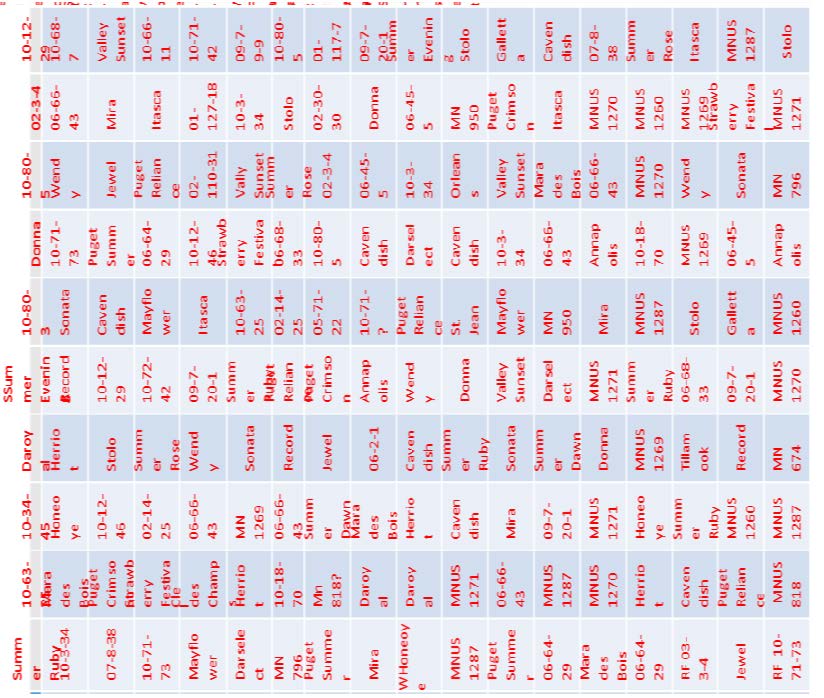
• 2012-planted large trial has 60 genotypes
(26 cultivars; 34 advanced breeding selections – 29 and 5 respectively from UW-River Falls and University of MN)
• 4 replications, plot size= 20’ (many trials at other universities going to 10’)
• Commercial production culture, except for limited pest control (no disease sprays, 1-2 insecticide apps. for TPB and clipper)
• Harvest season (very late)6/26/14 (1 day late for this area, starting) – 7/22/14; (15 days later than average of last 24 years)
• Very cold winter (worst tree fruit damage since 1983-84); good snow-cover for strawberries
To the right is a partial map of the large replicated trial at the UW-River Falls Fruit Research Facility.
‘Flavorfest’, ‘Lila’, ‘Laurel’, ‘Rutgers Scarlet’ and ‘Verity’ to a new trial. Good luck with your season!


